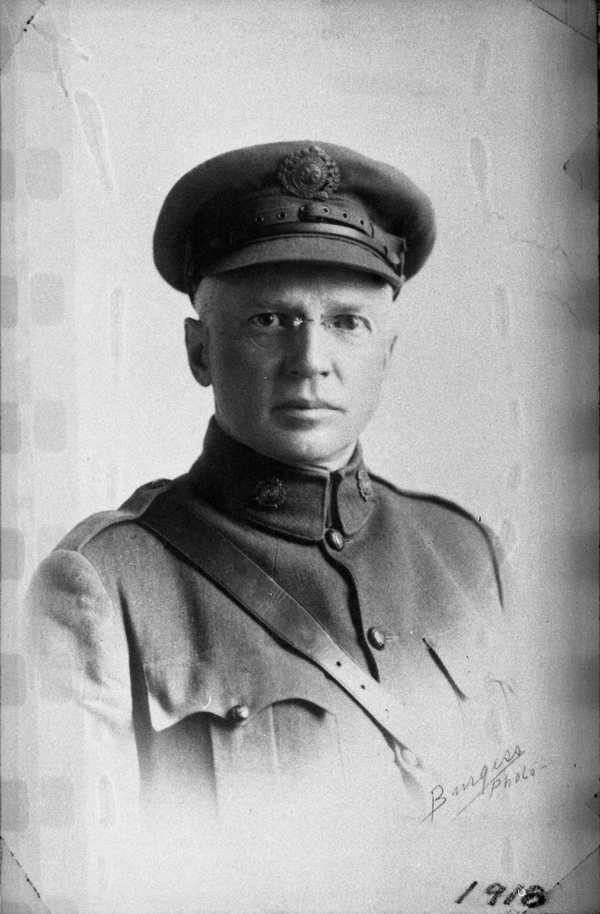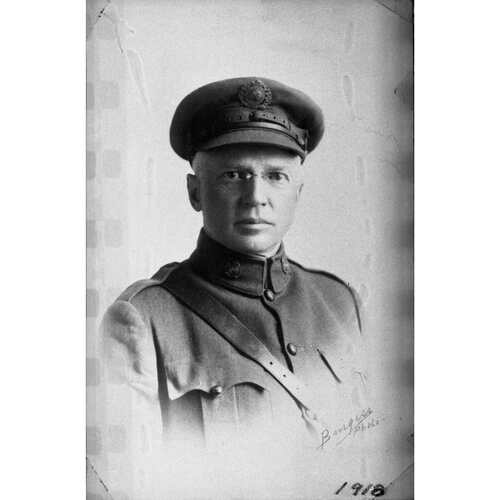
Source: Link
LITTLE, JAMES ARTHUR, banker, militia officer, businessman, and lumberman; b. 17 Jan. 1868 in Trenton, Ont., son of George Little and Mary E. Foster; m. 16 Nov. 1910 Ethel Marguerite Wardrope in Belleville, Ont., and they had a son and a daughter; d. 17 June 1931 in Port Arthur (Thunder Bay), Ont.
James Arthur Little was an enigmatic character whose professional life remains largely shrouded by the shadows that characterized natural-resources politics in early-20th-century Canada. He was raised in Trenton, where he attended school and later entered the employ of Molsons Bank [see William Molson*]. In 1903 he agreed to relocate to northern Ontario to manage the Port Arthur branch, a move that would lead to his profound involvement in the Lakehead’s development.
For a little over a decade, J. A. Little’s life in Port Arthur was generally unremarkable, but he was making valuable connections. In 1905, while working at the bank, he helped Lieutenant-Colonel Dr Charles Norval Laurie establish the 96th (Lake Superior) Regiment; Little was commissioned with the rank of major. When Laurie retired in 1911, Little was promoted lieutenant-colonel and put in command of the militia detachment, a post he would retain until 1921. The regiment was called on to provide aid to local police during a gun battle with striking coal handlers in 1912. During World War I it was responsible for guarding Port Arthur’s shipbuilding company, grain elevators, powerhouses, and wireless station.
Little resigned from the bank in 1919, by which time he and several of his contemporaries, such as Walter H. Russell, had apparently mastered navigation of the murky waters that surrounded access to government-controlled, or crown, resources and privileges. The arrangement typically involved obtaining the desired prize in exchange for making a contribution to the party or a local elected official; the partisan go-between often received a payment for brokering the deal. During the Conservative administration of Premier William Howard Hearst*, for example, Little, an avowed Tory, was granted virtually exclusive fishing privileges on Lake Nipigon and allegedly caught and sold sturgeon with little regard for quota regulations. Presumably the presence of his long-time business associate and friend Donald McDonald Hogarth on Ontario’s standing committee on game and fish aided and abetted Little’s cause in this regard. Similarly, Little and two of his partners formed the New Ontario Contracting Company Limited, which harvested lumber with impunity, despite infringement of provincial cutting provisions, along the National Transcontinental Railway line near Sioux Lookout. Little and his cronies used the same firm to cut pulpwood in the Thunder Bay district; thanks to a legal loophole that the Ontario government refused to close, they were able to export wood across the border from crown lands on which they had staked mining claims, thus turning a handsome profit for nominal expenditure.
Little’s political lifelines were severed when the Conservatives were defeated in 1919 by Ernest Charles Drury*’s party, the United Farmers of Ontario. The new government cancelled his fishing licences and appointed Francis Robert Latchford and William Renwick Riddell* to investigate possible violations of the Crown Timber Act in the Port Arthur area; Little escaped censure and denied allegations that he had bribed the erstwhile minister of lands, forests, and mines, George Howard Ferguson*, to achieve his aims. The following year Little, undaunted, joined with a number of Wisconsin paper makers to incorporate Nipigon Fibre and Paper Mills Limited near the village of Nipigon, northeast of Port Arthur. A sudden downturn in the pulp market during the 1920–21 recession sent the firm into receivership, but its major handicap had been the inability to secure a large timber limit from the provincial government.
The Conservatives, now led by Ferguson, were re-elected in 1923, but Little quickly discovered that his political stripe did not guarantee access to crown resources. He and Hogarth, who had not been returned to the legislature as mpp for Port Arthur, hatched a plan to secure control of the Lakehead’s jack pine forests in order to monopolize the district’s profitable railway-tie manufacturing sector. But their efforts were thwarted by rivals – namely Hogarth’s successor, Francis Henry Keefer*, and his pulpwood-exporting clients – who enjoyed greater influence with the imperious premier. Similarly, Little and Hogarth entered into an agreement with mining executive Noah Anthony Timmins, who in 1924 purchased Little’s pulp mill in Nipigon. The price was $50,000 in cash, and Little and Hogarth retained a 50 per cent interest in the enterprise, which Timmins intended to expand; in exchange, Little was to facilitate Timmins’s acquisition of the pulpwood limits he sought from the province. However, Little’s competitors persuaded Ferguson to grant a major portion of the timber in question to Keefer’s gang, thereby drastically diminishing the woodland available to Timmins.
On the occasions when Little was successful in exploiting his connections, the dividends for him and the members of his cabal were lucrative indeed. During the mid 1920s he and his associates negotiated a secret $100,000 pay-off from the Consolidated Water Power and Paper Company in Wisconsin for ensuring that the firm was granted a timber limit. Little also engineered a truly extraordinary ruse whereby he and Hogarth (re-elected mpp in 1926) delivered to Consolidated a rich pulpwood tract north of Sault Ste Marie. The stratagem, which Ferguson personally approved, involved having senior officials in the Department of Lands and Forests fabricate ludicrous timber cruises to rationalize the deal. Little and Hogarth profited to the tune of $500,000, although they were expected to share their riches by contributing roughly 10 per cent of their return to the federal coffers of Richard Bedford Bennett*’s Tories during the 1930 election campaign. In the same year Little arranged for his brother-in-law, George Calvin Wardrope, to win a fixed tender for a timber licence; Wardrope promptly flipped it to a bona fide operator at a higher price. It was perhaps ironic that, two years earlier, Little’s own contracting firm, the Thunder Bay Harbor Improvement Company Limited, had won an open competition for a timber tract near Port Arthur, but at a higher price than he wanted to pay. Just before the Tories, now led by George Stewart Henry*, lost to Mitchell Frederick Hepburn*’s Liberals in 1934, they reduced the stumpage fees to benefit Little’s widow.
Interestingly, Little played a posthumous role in a remarkable intrigue that testifies to the political machinations of the period. Shortly after his death from heart failure brought on by pneumonia, his private papers, which revealed shady and often illicit dealings with government officials, were acquired by one of his nemeses, Charles Winnans Cox, whose foes alleged that he had stolen these “dead man’s letters.” The Conservatives in Ottawa and Queen’s Park were cowed by the Liberal timber contractor’s threats to make the documents public, and Hogarth conceded the Tories’ long-held provincial seat in Port Arthur to Cox in the 1934 election. Cox began exploiting his new position for personal gain, but within a few years his enemies had gathered enough incriminating information to hoist him with his own petard.
Undoubtedly, many in the Thunder Bay district would have regarded Cox’s malevolent use of Little’s letters as a case of “the colonel” finally getting his just deserts, even though he was not around to receive them. Despite engaging in some community work – Little played a leading role in reviving the Port Arthur Golf and Country Club – he was far better known for being a harsh and imperious disciplinarian than for being a benevolent soul. His political involvement was driven almost entirely by self-interest, and he was repeatedly in the courts defending against or launching lawsuits; he was even found guilty of beating the 69-year-old gardener at his summer retreat outside Port Arthur.
Little’s career provides a window into some of the vicissitudes that pervaded the exploitation of crown resources in the early 20th century by entrepreneurs who gained access to them through political channels. Just before his death, Little’s assets were valued at roughly $500,000 – a fortune that reflected the tangible rewards connections could garner. But knowledge of his chequered record in dealing with the government suggests there were even more princely sums available for the taking during those years.
The author wishes to acknowledge the assistance of Thorold Tronrud, director/curator of the Thunder Bay Museum, in Ontario, in the preparation of this biography.
AO, F 208, MU 1570 (Charles W. Cox MLA corr.), 1922–36; RG 1-246-3, no.7608, 1915–19 and no.32405 (J. A. Little to B. Bowman, 1 March 1923); RG 3-4-0-190, G. W. Mason to W. E. Raney, 7 Sept. 1920; RG 18-79, Proc. of Timber Commission, vol.2 (1920): 1550–89; RG 75-57, PC209/18; RG 80-5-0-413, no.12146; RG 80-8-0-1302, no.32448. Lakehead Univ. Arch. (Thunder Bay), MG7, O. Styffe to News-Chronicle, 3, 10, 27 Feb. 1941. Ont., Ministry of Govt. and Consumer Services, Companies and personal property security branch (Toronto), Dormant corporation files, TC 17628 (Nipigon Fibre & Paper Mills Ltd). Thunder Bay Museum, A83 (James A. Little/Donald M. Hogarth fonds), ser.1 (general corr.), file 1, Statements by Messrs Walter Oliver and George Horrigan, 18 Oct. 1919, file 2, J. A. Little to D. M. Hogarth, 27 April 1922, all items in files 3, 4, and 5, and in 7, J. A. Little to D. M. Hogarth, 12 Aug. 1930 and W. Lawr to O. A. Knights, 2 June 1932; ser.2 (special corr. and agreements), all items in file 1, and in 2, E. B. Redford to J. A. Little, 7 Feb. 1927 and enclosure of 8 April 1926; ser.3 (financial records), file 1, financial statement of J. A. Little, 30 April 1930. Hush (Toronto), 24 Feb. 1934. News-Chronicle (Port Arthur [Thunder Bay]), 18 June 1931, 1 Feb. 1941. Toronto Daily Star, 22 June, 5 Aug. 1920. J. P. Bertrand, Timber wolves: greed and corruption in northwestern Ontario’s timber industry, 1875–1960 (Thunder Bay, 1997). Mark Kuhlberg, “‘Nothing but a cash deal’: crown timber corruption in northern Ontario, 1923–1930,” Thunder Bay Hist. Museum Soc., Papers and Records, 28 (2000): 3–22. H. V. Nelles, The politics of development: forests, mines & hydro-electric power in Ontario, 1849–1941 (Toronto, 1974). F. B. Scollie, Thunder Bay mayors & councillors, 1873–1945 … (Thunder Bay, 2000), 146–47. G. F. G. Stanley, In the face of danger: the history of the Lake Superior Regiment, intro. R. A. Keane (Port Arthur, [1960]). Thunder Bay Museum, “[The Lake Superior Regiment, a history]”: www.thunderbaymuseum.com/exhibits/virtual-exhibits/lake-superior-regiment (consulted 5 Oct. 2015).
Cite This Article
Mark Kuhlberg, “LITTLE, JAMES ARTHUR,” in Dictionary of Canadian Biography, vol. 16, University of Toronto/Université Laval, 2003–, accessed December 27, 2025, https://www.biographi.ca/en/bio/little_james_arthur_16E.html.
The citation above shows the format for footnotes and endnotes according to the Chicago manual of style (16th edition). Information to be used in other citation formats:
| Permalink: | https://www.biographi.ca/en/bio/little_james_arthur_16E.html |
| Author of Article: | Mark Kuhlberg |
| Title of Article: | LITTLE, JAMES ARTHUR |
| Publication Name: | Dictionary of Canadian Biography, vol. 16 |
| Publisher: | University of Toronto/Université Laval |
| Year of publication: | 2017 |
| Year of revision: | 2017 |
| Access Date: | December 27, 2025 |



